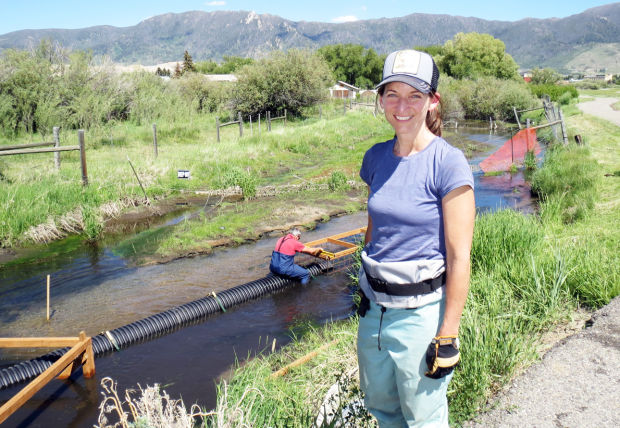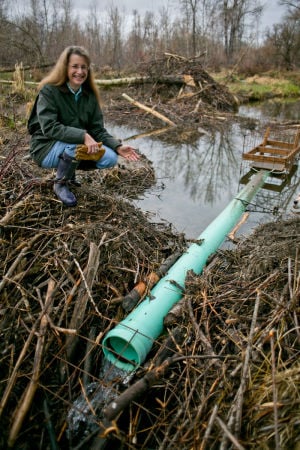As California continues to set itself on fire like a Hindi widow faithful, it might be useful to think specifically of one thing in particular that beavers do. They happen to do it better than anyone else in the world. And its all they do, every day, everywhere, 24/7 with minimal tools, for free.
Can you guess where I’m going with this? All the way to Alberta and this great article by Brenda Schoepp.
What do you want your fresh water used for?
It all began with industrious engineers who understood hydrology and the importance of water. They built dams and created wetlands throughout Canada, and in doing so had a system in place for water preservation and purification.
 The harvest of the beaver had an impact on wetlands and our current-day contribution to climatic change. Wetlands are multifunctional systems that purify water and encourage a system of regeneration. It is estimated that 70 per cent of wetlands in Canada (65 per cent in Alberta) have been lost as part of this disruption in the natural order of things.
The harvest of the beaver had an impact on wetlands and our current-day contribution to climatic change. Wetlands are multifunctional systems that purify water and encourage a system of regeneration. It is estimated that 70 per cent of wetlands in Canada (65 per cent in Alberta) have been lost as part of this disruption in the natural order of things.
How do we protect the quality of the water when we don’t know what beavers know? How do we use less water when the economy is exploding? Do we fully appreciate and understand the profound relationship between action and consequence? And is there a political will to invest in science and technology to ensure water for all?
Good questions every one. And there probably isn’t a single answer, but one of them surely is furry. This is as good a time as any to revisit this wonderful chestnut by Ralph Maughan for Wildlife News.
Beaver restoration would reduce wildfires
After almost every large wildfire or fires that do significant damage to structures, people ask for proactive measures. The desire for this is rational. It needs no explanation.
The most common plausible sounding solution used in the Western United States is large scale fuel reduction — little fuel; little fire. A big problem with fuels reduction is that you have to pay to have it done. Potential fuel covers hundreds of millions of acres. We say “potential” fuel because what will burn varies greatly. Some years are too wet. Every year hundreds of fires burn out, but a wind, not drought could make them quickly into great conflagrations. Politicians often use the words “logging” and “fuel reduction” in the same breath, but commercial logging, where the land owner gets paid, only works for good timber. That’s mostly not what is burning. Dry brush, droughty green trees, dying or dead trees, cheatgrass, and annual weeds — that’s what is usually burning. It is difficult and far too expensive to eliminate these.
 One idea that is rarely mentioned is to keep the stream bottoms green and raise the humidity. How could this be done? Let’s restore beaver to the creeks of the Western United States. This is much less expensive than cutting out or clearing potential fuels. It also has significant fish and wildlife benefits. We can often add flood control too, plus the recharge of aquifers.
One idea that is rarely mentioned is to keep the stream bottoms green and raise the humidity. How could this be done? Let’s restore beaver to the creeks of the Western United States. This is much less expensive than cutting out or clearing potential fuels. It also has significant fish and wildlife benefits. We can often add flood control too, plus the recharge of aquifers.
A string of beaver ponds up a drainage is like a permanent fire break. The ponds not only enlarge the area covered with water, more importantly, they increase the portion of the creek or streamside area (the riparian zone) that stays green all summer. They raise the ground water level. Beaver ponds also increase the humidity of air in the drainage. The result is fewer hours in a day when wildfires can burn hot and hard.
Beaver could be a powerful tool to tame the effects of climate change.
Can we talk about those spongy marshlands that beavers make now? Can California look up from the raging torrents in Redding and Clearlake and think, gosh maybe I should be using a different method to clean my culverts besides killing the water-savers.
Anyone who puts two and two together will come up with this.





 I’m not sure there’s a lot of merit to what he’s saying, at least for western landscapes, especially in mountainous terrain. I could see in some wide valleys where beaver have been removed, conifers are encroaching, and the area hasn’t already been cleared for development, that beavers could make a difference, but any effects from more beaver would probably be pretty localized, and in large fires that isn’t enough. A burning ember can travel up to a mile, they say. One could even make the case that increased humidity may increase growth of trees
I’m not sure there’s a lot of merit to what he’s saying, at least for western landscapes, especially in mountainous terrain. I could see in some wide valleys where beaver have been removed, conifers are encroaching, and the area hasn’t already been cleared for development, that beavers could make a difference, but any effects from more beaver would probably be pretty localized, and in large fires that isn’t enough. A burning ember can travel up to a mile, they say. One could even make the case that increased humidity may increase growth of trees 






































